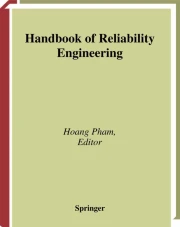
This is a preview of subscription content, log in via an institution to check access.
eBook EUR 160.49
Price includes VAT (France)Softcover Book EUR 210.99
Price includes VAT (France)Hardcover Book EUR 210.99
Price includes VAT (France)Tax calculation will be finalised at checkout
An effective reliability programme is an essential component of every product's design, testing and efficient production. From the failure analysis of a microelectronic device to software fault tolerance and from the accelerated life testing of mechanical components to hardware verification, a common underlying philosophy of reliability applies. Defining both fundamental and applied work across the entire systems reliability arena, this state-of-the-art reference presents methodologies for quality, maintainability and dependability. Featuring: Contributions from 60 leading reliability experts in academia and industry giving comprehensive and authoritative coverage. A distinguished international Editorial Board ensuring clarity and precision throughout. Extensive references to the theoretical foundations, recent research and future directions described in each chapter. Comprehensive subject index providing maximum utility to the reader. Applications and examples across all branches of engineering including IT, power, automotive and aerospace sectors. The handbook's cross-disciplinary scope will ensure that it serves as an indispensable tool for researchers in industrial, electrical, electronics, computer, civil, mechanical and systems engineering. It will also aid professional engineers to find creative reliability solutions and management to evaluate systems reliability and to improve processes. For student research projects it will be the ideal starting point whether addressing basic questions in communications and electronics or learning advanced applications in micro-electro-mechanical systems (MEMS), manufacturing and high-assurance engineering systems.
From the reviews:
[T]here are some new topics included in the Handbook which make it a valuable addition to the literature and the reviewer would like to recommend the Handbook to practitioners and serious minded students and teachers." (Krisnha B. Misra, International Journal of Performability Engineering, Vol. 3, (3), 2007)
"Organised into 35 chapters written by 45 experts in the relevant fields, this handbook gives a very broad overview into important areas within reliability. Each chapter describes a number of different methods in use and many conclude with a discussion of open problems. All contain a long list of references to the scientific literature. … this book is well worth getting as a reference volume in your library, and provides an excellent way of getting new researchers up to speed! (Tim Bedford, ESRA Newsletter, January, 2005)
"This Handbook of Reliability Engineering, altogether 35 chapters, aims to provide a comprehensive state-of-the-art reference volume that covers both fundamental and theoretical work in the areas of reliability … . The handbook’s cross-disciplinary scope ensures that it serves as an indispensable tool for researchers in industrial, electrical, electronics, computer, civil, mechanical and systems engineering. … they all will be forced to take into account the excellent contributions appearing in this Handbook of Reliability Engineering." (Current Engineering Practice – online, Vol. 47, 2004/2005)
"The book … contains all the latest developments in concepts and the state-of-the-art techniques about reliability … . This book has thirty-five well-written excellent chapters by sixty leading authorities … . A reader, whether new to reliability concepts and techniques or a reasonably well-versed expert in reliability topics, should consider having this thought provoking book … . All reliabilists, professional engineers, medical and health researchers, graduate students andprofessors, industrial statisticians, numerical mathematicians, and software engineers would benefit greatly by reading … this book." (Ramalingam Shanmugam, Journal of Statistical Computation and Simulation, Vol. 75 (6), 2005)